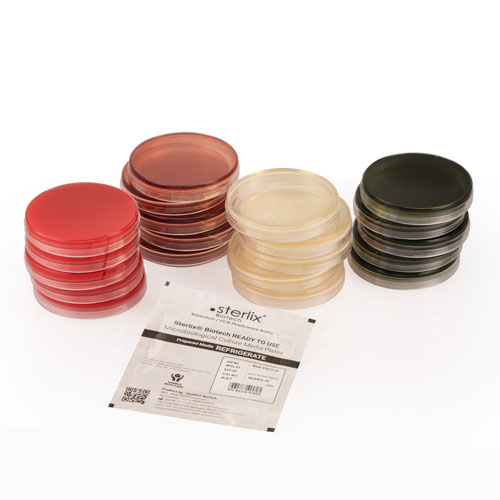STERLIX® Chocolate Ready To Use Agar Plate
Product Details
Chocolate agar plate, also known as heated blood agar or Thayer-Martin agar, is a specialized culture medium used in microbiology laboratories. It is called "chocolate" agar because the heat used during its preparation gives the medium a brown color, resembling melted chocolate.
The main component of a Chocolate agar plate is blood, usually sheep blood, which provides essential nutrients for the growth of fastidious bacteria. The preparation process involves heating the blood agar, which causes the release of various nutrients and growth factors from the red blood cells, making them more readily available for bacterial growth.
Chocolate agar plates are commonly used for the isolation and cultivation of fastidious organisms, particularly Neisseria species, including Neisseria gonorrhoeae and Neisseria meningitidis. These bacteria have specific growth requirements and may be difficult to culture on standard media.
The chocolate agar plate provides a rich and supportive environment for the growth of these bacteria by supplying the necessary nutrients, such as vitamins, amino acids, and other growth factors. The heated blood also creates a favorable environment for the growth of other fastidious organisms.
Additionally, the chocolate agar plate can be supplemented with antibiotics or selective agents to inhibit the growth of normal flora or unwanted bacteria, allowing for the selective isolation of specific pathogens.
The use of Chocolate agar plates, along with specific incubation conditions, helps in the diagnosis and identification of pathogenic bacteria, especially those associated with sexually transmitted infections (such as N. gonorrhoeae) and meningitis (such as N. meningitidis).
The main component of a Chocolate agar plate is blood, usually sheep blood, which provides essential nutrients for the growth of fastidious bacteria. The preparation process involves heating the blood agar, which causes the release of various nutrients and growth factors from the red blood cells, making them more readily available for bacterial growth.
Chocolate agar plates are commonly used for the isolation and cultivation of fastidious organisms, particularly Neisseria species, including Neisseria gonorrhoeae and Neisseria meningitidis. These bacteria have specific growth requirements and may be difficult to culture on standard media.
The chocolate agar plate provides a rich and supportive environment for the growth of these bacteria by supplying the necessary nutrients, such as vitamins, amino acids, and other growth factors. The heated blood also creates a favorable environment for the growth of other fastidious organisms.
Additionally, the chocolate agar plate can be supplemented with antibiotics or selective agents to inhibit the growth of normal flora or unwanted bacteria, allowing for the selective isolation of specific pathogens.
The use of Chocolate agar plates, along with specific incubation conditions, helps in the diagnosis and identification of pathogenic bacteria, especially those associated with sexually transmitted infections (such as N. gonorrhoeae) and meningitis (such as N. meningitidis).

